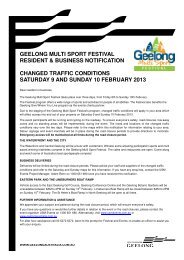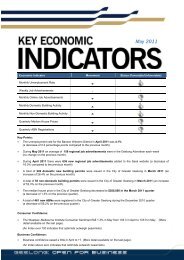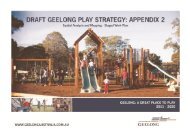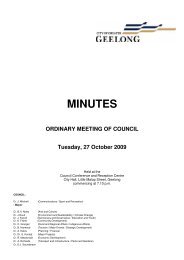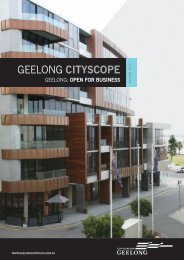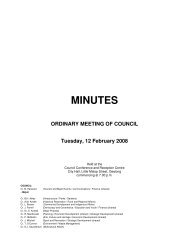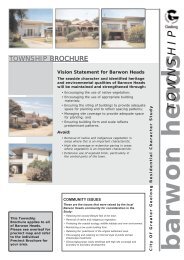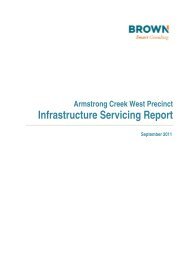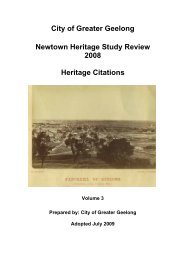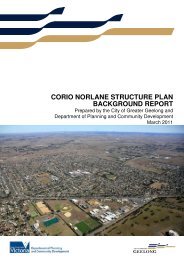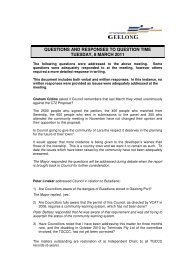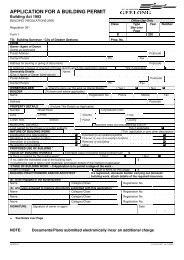armstrong creek urban growth plan volume 1 - City of Greater Geelong
armstrong creek urban growth plan volume 1 - City of Greater Geelong
armstrong creek urban growth plan volume 1 - City of Greater Geelong
Create successful ePaper yourself
Turn your PDF publications into a flip-book with our unique Google optimized e-Paper software.
nature strips are minimised. Wider roads should not be contemplated unless<br />
absolutely necessary, due to their increased barrier effect.<br />
Minimal width is particularly important at intersections, where pedestrians are most<br />
likely to be wishing to cross the arterial. Therefore, all intersections with arterial<br />
roads will be signalised. Signals will also aid pedestrians wishing to cross the road.<br />
A high quality environment<br />
As noted above, arterial roads will inevitably be used as local connector streets in<br />
addition to their sub-regional and regional ‘through traffic’ functions. Therefore, it is<br />
important that they are attractive roads—to contribute to a high quality image for<br />
the development as a whole—and that they <strong>of</strong>fer reasonable pedestrian and cycle<br />
amenity—to contribute to the attractiveness <strong>of</strong> the development as a whole and<br />
encourage walking and cycling.<br />
There are a number <strong>of</strong> ways in which arterial roads can be designed to contribute<br />
to a high quality environment. These are:<br />
<br />
<br />
<br />
<br />
<br />
Where they are not edged by parks (including retarding basins), they should<br />
be edged by building ‘fronts’, rather than high fences or service yards<br />
associated with the ‘sides’ or ‘backs’ <strong>of</strong> buildings. This means that there<br />
would need to be service roads to provide access to the abutting properties.<br />
They should have generously broad shared paths where there is adjoining<br />
development.<br />
They should have large trees along both nature strips and on any central<br />
median and outer separators (specified in accordance with road safety<br />
standards).<br />
Their design speed should be minimised, to lessen the likelihood <strong>of</strong><br />
pedestrians feeling unsafe when they are walking along them.<br />
Grade-separated intersections should not be contemplated unless absolutely<br />
necessary, as they blight the surrounding environment and, in particular,<br />
land alongside through their visual impacts and restrictions on access.<br />
Multi-carriageway boulevards<br />
As noted above, service roads are required to enable buildings to ‘front’ arterial<br />
roads. This creates a multi-carriageway ‘boulevard’, which can be a very attractive<br />
street despite the fact that this increases the overall width <strong>of</strong> the road (eg. St Kilda<br />
Road).<br />
In essence, a multi-carriageway boulevard divides the traffic into a number <strong>of</strong><br />
carriageways. The separators between these carriageways provide ‘staging posts’<br />
ARMSTRONG CREEK URBAN GROWTH PLAN / VOLUME 1 (ADOPTED 13 MAY 2008, AMENDED MAY 2010)<br />
109



